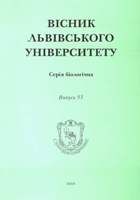

 | Наукова періодика України | 
| Вісник Львівського університету |
Revka O. Platelets influence coagulation and fibrinlysis thereby regulating hemostatic balance / O. Revka, I. Patalakh, T. Grinenko // Вісник Львівського університету. Серія біологічна. - 2016. - Вип. 73. - С. 257. - Режим доступу: http://nbuv.gov.ua/UJRN/VLNU_biol_2016_73_66 Background. Physiologically hemostasis system keeps blood in a liquid state. At the same time it maintains coagulation and thrombus formation after vessel damage, preventing blood loss. It is noteworthy that the size and the time of thrombus existence are under a strict control of coagulation and fibrinolysis processes that have to be balanced under physiological conditions. There is a risk of hypoperfusion (due to the vessel's blocking by thrombus) or hemorrhage in case of hemostatic imbalance. Plasma proteins provide processes of thrombus formation and lysis. Along with the plasma proteins, blood cells, such as platelets, are important component of hemostasis. To date, the task of developing new methods and approaches to evaluate the global impact of platelets on coagulation and fibrinolysis is still topical. The aim of the study was to investigate the influence of platelets on the dynamics of plasma clots' coagulation and subsequent lysis as well as on the overall balance between the processes of coagulation and fibrinolysis. Methods. Platelet rich plasma with 50 000 and 300 000 cells/<$Emu l> was used for the investigation of platelets' influence on the processes of thrombus formation and subsequent lysis. Plasma coagulation was initiated by adding either 0,025 M calcium chloride or 0,025 calcium chloride with 0,05 NIH/ml thrombin. Coagulation and subsequent full lysis were studied on plasma containing 40 IU/ml rt-PA (Actilyse, EMC) with autologous cell free plasma as control. The dynamics of fibrin clots formation and subsequent lysis was registered by continuous measurements of absorbance at 405 nm. The obtained curves of coagulation/lysis (i.e., absorbance as a function of time) was used to determine following parameters: lag time (initiation stage of the coagulation process), initial rate of the absorbance increment (clot growth during propagation stage), maximal absorbance (the total fibrin level), time of the beginning of absorbance decrement (the beginning of lysis), time of the absorbance decrease by half (half-lysis and half-life time of the clot). Results. All calcium-dependent steps of the inner coagulation cascade were initiated by adding calcium chloride to plasma. Under these conditions, the presence of platelets (50 000 and 300 000 cells/<$Emu l>) caused 32 and 56 % decrease of lag time, and 10 and 40 % increasing of initial clotting rate, respectively. The initiation of coagulation by calcium chloride and thrombin was used to activate the terminal reactions of the coagulation cascade. In these case platelets (300 000 cells/<$Emu l>) decreased initial clotting rate and total fibrin level by 20 and 16 %, respectively, compared to control. After calcium chloride addition in plasma containing rt-PA platelets, on the one hand, shortened the lag time up to 3,8 times and increased initial clotting rate by more than twice; on the other hand, they accelerated the beginning of the lysis of the clots nearly two times relating to the control. Also, platelets in this case, either with or without thrombin, decreased the total fibrin level and shortened half-lysis time and half-life time of the plasma clotting in direct proportion to the cell number. Moreover, total fibrin level additionally decreased in the presence of platelets in plasma containing rt-PA comparing to plasma without rt-PA, providing evidence for the shifting of hemostatic balance towards the prevalence of fibrinolytic processes. Conclusions. The obtained data gives the evidence that platelets act both as procoagulants and fibrinolytics thereby regulating hemostatic balance. Probably, under physiological conditions, they first promote coagulation, and then predominately stimulate fibrinolysis hence regulating the size of the fibrin clot and preventing thrombosis. Цитованість авторів публікації: Бібліографічний опис для цитування: Revka O. Platelets influence coagulation and fibrinlysis thereby regulating hemostatic balance / O. Revka, I. Patalakh, T. Grinenko // Вісник Львівського університету. Серія біологічна. - 2016. - Вип. 73. - С. 257. - Режим доступу: http://nbuv.gov.ua/UJRN/VLNU_biol_2016_73_66.Додаткова інформація про автора(ів) публікації: (cписок формується автоматично, до списку можуть бути включені персоналії з подібними іменами або однофамільці) |
|
|
Всі права захищені © Національна бібліотека України імені В. І. Вернадського |
|||||